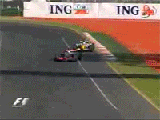I found parts of the original Whiting interview which was on Autosport's subscription section on another board.
My overall thoughts are that it was just a crash," says the FIA's safety delegate and race director Charlie Whiting. "A guy went off, hit the wall quite hard, and came out of it unhurt, which was good. It happens all the time. I don't really understand why everyone has talked about it so much!
"But yes, it was a fairly spectacular crash. I don't know what the causes were, that's another story altogether. But in terms of the effects, it was very pleasing. Everything did exactly what we would expect. Having said that, I think we can always learn something."
Perhaps the most important safety development of recent years is not an item that has a direct bearing on the driver's health, but rather has provided the FIA with valuable guidance on what actually works.
The accident data recorder now fitted to each car - in testing as well as at Grands Prix - provides details that previously could only be estimated. Every major accident can be studied, and the results used in future developments.
"It tells us what happened, as opposed to guessing," says Whiting. "We used to look at accidents and say 'he didn't slow down at all, did he?' People shouldn't say anything until they know what they're talking about it. We don't say anything until we analyse things, because appearances can be deceptive.
"Heikki's was a big accident, but it was a long accident, in that it was over 100 milliseconds, which is bloody long by crash pulse standards. Hence the reason for his very low deceleration of 27g.
"The speed at which he lost control is in the data recorder, but once he's lost control, you don't have wheel speeds any more. But you can calculate the velocity from the deceleration, and come up with a figure that is not only accurate, but also quite surprising.
"Anyone who says that the car didn't slow down at all, that's complete nonsense. The fact of the matter is that the car lost control at approximately 260km/h, and hit the wall at approximately 135 km/h."
Contrary to what many people thought, the McLaren did not go under the belt or the tyres. It actually went through the belt and into the tyres, in other words it did not go underneath the tyre wall and lift the whole lot up, it buried itself in them and lifted only those above the chassis.
"If you've got something relatively sharp like a nose, the fact that the tyres are bolted together is going to mean nothing. That's why we need conveyor belts. They are OK, but we know that at high speed, they can still be penetrated.
"Over the last two and half years we've had a very intensive programme going on with regard to very high speed barriers. This was highlighted by the first test we did, with a trolley with an F1 nose on it, when we saw how easily it penetrated even the thickest available conveyor belt.
"Heikki's car split the belt about 40cm above the ground. That's where it first hit, and it penetrated and then went through the tyres. When I looked at the pictures I thought it had gone under it. But when you look at it closely, it didn't actually go under it, which is another example of why I think it's important to get as many facts as possible before saying anything."
The accident has put an extra focus on the barriers developed by TecPro, which were seen at Monza in 2006. The fact that the GPDA chose that weekend to make a fuss about safety at the track - seemingly oblivious to the fact that a major development was being introduced - did not go down well with the FIA.
"We put the TecPro barriers in front of tyres at the second chicane and Parabolica. They incorporate a 4mm thick layer of steel, and that stops the nose actually going through it, and consequently it uses the tyres as opposed to actually penetrating them, as it were. So the things we can learn from last weekend are that asphalt could have performed better, and a TecPro barrier could have prevented penetration."
I have now edited my retranslation English-German-English in favour of the original version 3.5.2008 12 am.
my personal view is that the 4 mm steel sheet inside the ThecPro element with the foam and the thick polymer drum will be a very good retension element and capable of absorbing much energy while it is pierced.
from this interview it is still unclear when the 135 km/h speed applied. for me it reads like that was the moment when the nose cone hit the concrete wall behind the tyre barrier. I would be interested to know how much the gravel trap slowed the car before the tyre wall slowed it down. from that information we can conclude a great deal. for instance if Webber's request for wider gravel traps at turn 9 makes sense. or would it be better to optimise the energy absorbing barrier by putting one or two layers of tecpro there.
Massa said:
... The only unusual feature was that the car went under and through the tyre barrier and so did his head. That is a bit scary and I think the FIA should look into the construction of the whole barrier system. ...
it sounds like the TecPro will get some more promotion








